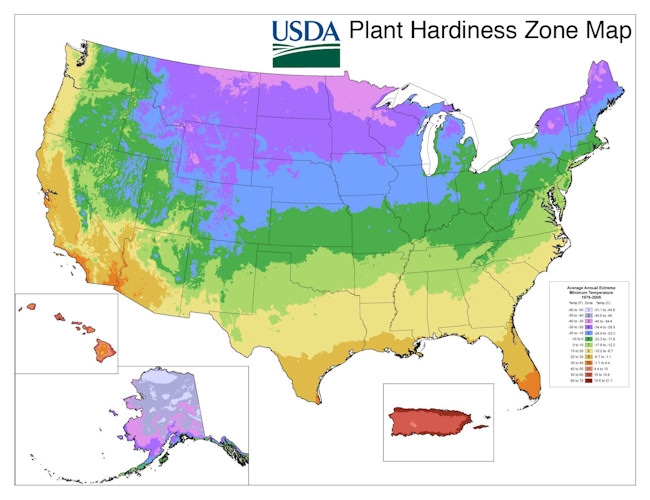
Properly winterizing the garden will not only help ornamental plants survive the short gray days and cold nights ahead. It's also an important step in ensuring the garden will produce in the spring.
Here is a checklist to winterize your garden.
- Know your USDA zone. Understanding the average annual extreme minimum winter temperature is important in creating an action plan. That information
- is available for every county in
- the country on the USDA website. To find the likely dates of your first frost and last anticipated frost, contact our local agricultural extension service.
- Chop, clip, cut and clean. Tidy up the garden by removing spent stalks and other plant debris that might become a winter incubator for pests and diseases. Removing dead and dying foliage will give your garden a cared-for look all winter and free you from grooming chores in the spring when you'd rather be doing fun things such as adding new plants to the garden.
- Remove weeds now, especially invasive ones. Pull out any weeds or other unwanted plants. Place invasive plants--especially the seed heads — in a covered garbage container, not in your compost pile.
- Divide perennials. Fall is a good time to divide a wide variety of plants in Napa County. Divide them at least six weeks before the first frost so they get established before freezing weather arrives. Candidates for division are clumping plants that don't flower as vigorously as they once did or those that have bare spots in the middle.
- Give the bulbs some love. Dig up and store tender bulbs that may not survive freezes. Dry them on newspaper for several weeks and then put them in a container and cover with sawdust, sand, perlite or vermiculite until they're ready to be replanted. If a few recurring frosty nights are predicted, add an extra layer of mulch to hardy bulbs you've left in the ground.
- Baby the beds. After tidying up the garden and replanting divided plants, add three to four inches of compost to the beds. Nutrients from the mulch will leach into the beds during winter rains. In the spring, you can dig the remnants of the compost into the soil.
- Spread mulch. This task is especially important for newly planted perennials, such as native species that haven't had time to develop an extensive root system.The mulch will help keep the soil temperature relatively consistent until spring and prevent temperature extremes that might cause the ground to uproot new plants. Check the mulch in January and February; if it has thinned out because of winter weather or other reasons, add more mulch.
- Hydrate evergreens.Deep soaks in the fall are important if autumn has been dry, as ours has been so far. Conifers, such as yews, and broadleaf evergreens, such as hollies and boxwoods, are susceptible to winter burn because they release moisture through their leaves year-round. Pay particular attention to broadleaf types that have a south or southwest exposure to the afternoon sun, and give them extra water as needed.
- Protect bark on young trees. Newly planted trees, especially fruit trees, have thin bark that can suffer sun scald or crack from fluctuating day-to-night temperatures. Tree wrap tape and plastic spiral tree protectors can help prevent this problem. Remove the tape as soon as the weather warms.
- Create wind breaks. Exposed evergreens, including citrus, are also susceptible to wind burn. In the fall, drive three stakes into the ground on the windward side of plants you want to protect. Put the stakes in a “V” formation with the front stake facing the wind and wrap burlap or landscape fabric around the stakes. It is not necessary to wrap the entire plant.
- Save shrubs. Wrap tender shrubs in burlap or agricultural fabric when freezing nights are forecast. Remove the fabric when the temperature warms to prevent overheating. Don't use plastic. Plastic doesn't breathe and can result in high temperatures that will “cook” the plant.
- Protect citrus. The University of California provides this downloadable information on protecting citrus from frost damage:http://homeorchard.ucdavis.edu/8100.pdf.
- Review your water features. The number-one rule is: don't allow the pump to freeze. Check with pond-maintenance experts about whether your pump will move water all winter or whether it and the plants in the pond should be removed and stored until spring.
- Plant cool-season vegetables. Throughout fall and winter, Napa County gardeners can grow crops such as lettuce, spinach, kale, beets, broccoli, cauliflower and Brussels sprouts. If you are ready to tackle cool- season vegetables, check out these guidelines from the Marin County Master Gardeners:http://bit.ly/ZVEIbn.
What tactics do you use to winterize your garden? Share your techniques and success stories on our Facebook page: UC Master Gardeners of Napa County. Include photos or videos that might help other gardeners winterize their ornamental and vegetable beds.
Workshop: Napa County Master Gardeners will lead a workshop on “Winterizing Your Garden” on Saturday, November 1, from 9:30 a.m. to 11:30 a.m., at University of California Cooperative Extension, 1710 Soscol Avenue, Napa. Learn the importance of winterizing and receive a checklist guide. Online registration (credit card only)Mail-in registration (cash or check only).
Master Gardeners are volunteers who help the University of California reach the gardening public with home gardening information. Napa County Master Gardeners ( http://ucanr.org/ucmgnapa/) are available to answer gardening questions in person or by phone, Monday, Wednesday and Friday, 9 a.m. to Noon, at the U. C. Cooperative Extension office, 1710 Soscol Avenue, Suite 4, Napa, 707-253-4143, or from outside City of Napa toll-free at 877-279-3065. Or e-mail your garden questions by following the guidelines on our web site. Click on Napa, then on Have Garden Questions? Find us on Facebook under UC Master Gardeners of Napa County.